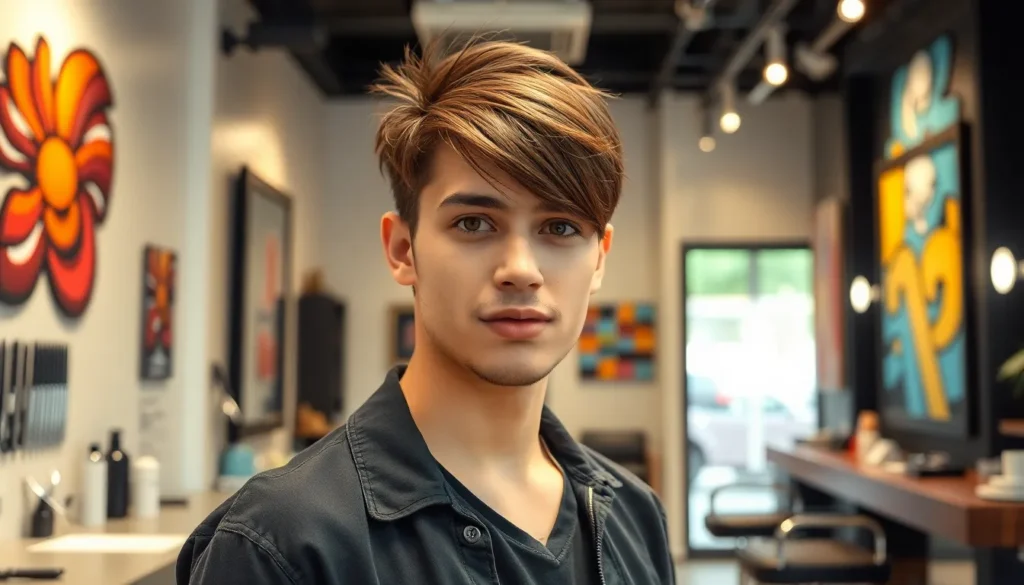We’ve all seen that one guy who walks into a room and instantly commands attention – and more often than not he’s sporting a perfectly styled fringe. Fringe haircuts for men have exploded in popularity over the past few years transforming from a niche trend into a mainstream style statement that works for virtually every face shape and hair type.
Whether you’re looking to add texture to fine hair or tame thick unruly locks a well-cut fringe can completely revolutionize your entire look. From textured crops and modern quiffs to sleek side-swept styles the versatility of men’s fringe cuts offers endless possibilities for personal expression.
We’re here to break down everything you need to know about fringe haircuts – including the most popular styles how to choose the right cut for your face shape and essential styling tips that’ll keep you looking sharp. Get ready to discover why the fringe might just be the game-changing haircut you’ve been searching for.
Classic Side-Swept Fringe for Professional Men
The classic side-swept fringe strikes the perfect balance between modern style and workplace appropriateness. This versatile cut works exceptionally well for professional environments where you need to maintain a polished appearance while expressing your personal style.
Business-Appropriate Styling Tips
Start with damp hair to achieve the most controlled and lasting side-swept fringe. Towel dry your hair gently, leaving it about 70% dry for optimal styling conditions.
Apply a volumizing mousse from roots to mid-lengths before blow drying. This creates the foundation for a professional look that won’t fall flat during long workdays.
Use a round brush while blow drying to direct your fringe to one side. Pull the brush through your fringe while following with the hair dryer to create natural movement and body.
Sweep your fringe diagonally across your forehead rather than straight across. This technique creates a more sophisticated appearance that complements business attire and facial structure.
Keep the length moderate by ensuring your fringe doesn’t extend past your eyebrows. Professional environments typically favor cleaner lines and well-maintained proportions.
Finish with a light touch of styling cream to eliminate flyaways without creating a heavy or greasy appearance. The goal is natural-looking control that lasts throughout your workday.
Best Hair Products for Hold and Shine
Lightweight pomades provide the ideal combination of hold and professional shine for side-swept fringes. We recommend water-based formulas that wash out easily and don’t build up over time.
Texturizing sprays work exceptionally well for fine hair that needs extra grip and volume. These products add body without weighing down your fringe or creating stiffness.
Matte clay products offer strong hold with a natural finish that’s perfect for thick or coarse hair textures. They provide control while maintaining the hair’s natural movement and flexibility.
Hair creams with medium hold deliver smooth, controlled styling that looks effortless in professional settings. These products tame frizz while adding subtle shine that enhances your overall appearance.
Finishing hairsprays lock your style in place without creating crunchiness or visible residue. Choose alcohol-free formulas that provide flexible hold and can withstand humidity changes in office environments.
Pre-styling heat protectants should always be your first step when using blow dryers or styling tools. These products prevent damage while creating a smooth base for your side-swept fringe styling routine.
Textured Choppy Fringe for Casual Looks

Moving from workplace appropriate styles, a textured choppy fringe brings effortless sophistication to your everyday look. We love how this versatile cut delivers modern edge while maintaining easy wearability for various casual settings.
Creating Natural Movement and Volume
Apply sea salt spray to damp hair for instant texture and grip before styling your choppy fringe. We recommend working the product through your fringe section using your fingers to distribute it evenly from roots to ends. Your hair will gain natural texture that enhances the choppy layers.
Use a diffuser attachment on your blow dryer to maintain the fringe’s natural movement while adding volume. We suggest setting your dryer to medium heat and low speed to prevent frizz and maintain defined texture. Your choppy fringe will develop natural separation and body without appearing overdone.
Scrunch the fringe sections gently with your hands while the hair air dries for maximum texture enhancement. We find this technique works especially well for men with naturally wavy or slightly curly hair textures. Your fringe will settle into organic looking choppy pieces that complement casual outfits.
Finish with texturizing paste applied sparingly through the mid lengths and ends of your fringe. We prefer lightweight formulas that won’t weigh down the choppy texture or create stiffness. Your fringe will maintain flexible hold while showcasing the intentionally uneven lengths.
Maintenance and Trimming Schedule
Schedule trimming appointments every 4 to 5 weeks to maintain the choppy texture and prevent overgrowth. We recommend booking with a stylist experienced in textured cuts who understands how to preserve the intentional unevenness. Your choppy fringe requires precise trimming to maintain its casual yet polished appearance.
Request point cutting techniques during your appointments to enhance the textured, choppy effect. We suggest asking your stylist to vary the cutting angles to create natural looking irregularity in the fringe length. Your hair will maintain that effortlessly tousled appearance between salon visits.
Maintain the overall length between professional trims by carefully snipping any pieces that grow too long or lose their shape. We advise using sharp haircutting scissors and cutting vertically into the hair rather than straight across. Your DIY maintenance should focus only on obvious overgrowth to avoid disrupting the professional cut.
Deep condition monthly to keep your textured fringe healthy and prevent the choppy ends from appearing damaged. We recommend using protein based treatments that strengthen the hair cuticle without weighing down your texture. Your fringe will maintain its casual sophistication while staying resilient to daily styling.
Curtain Fringe for Men with Longer Hair

Curtain fringe men’s hairstyles offer versatility that works exceptionally well with medium to long hair lengths. This style creates natural separation down the center while maintaining the sophisticated edge that longer hair provides.
Parting Techniques for Face Shape
Round faces benefit from off center parting that creates asymmetrical curtain fringe placement. We recommend positioning the part about 1.5 inches from the center to add visual length and avoid emphasizing width.
Square faces work best with deeper side parts that soften angular jawlines through strategic fringe placement. The curtain effect should start higher on one side to create diagonal lines that counterbalance strong facial features.
Oval faces can handle center parting with equal curtain fringe distribution on both sides. This balanced approach enhances natural facial proportions without overwhelming delicate bone structure.
Heart shaped faces require lower parting positions that create wider curtain fringe coverage across the forehead. We suggest keeping the fringe slightly longer to minimize the appearance of a broader forehead area.
Long faces benefit from horizontal parting techniques that emphasize width rather than length. The curtain fringe should fall closer to the eyebrows to create the illusion of a shorter facial structure.
Styling Methods for Different Hair Types
Straight hair requires texturizing spray application before blow drying to create natural movement in curtain fringe sections. Use a round brush to lift the roots while directing hair away from the center part for optimal separation.
Wavy hair works naturally with curtain fringe styling through scrunching techniques that enhance existing texture. Apply leave in conditioner to damp hair and use a diffuser attachment on low heat to maintain wave patterns.
Curly hair needs moisture rich products to prevent frizz while maintaining curtain fringe definition. We recommend using curl defining cream and air drying with periodic scrunching to encourage natural curl formation.
Thick hair benefits from thinning techniques that reduce bulk while preserving curtain fringe movement. Use point cutting methods to create graduated lengths that allow the fringe to fall naturally without appearing too heavy.
Fine hair requires volumizing mousse application at the roots to create lift and body in curtain fringe areas. Blow dry with a paddle brush while lifting sections away from the scalp to maximize fullness and prevent flat appearance.
Blunt Cut Fringe for Bold Statement Styles
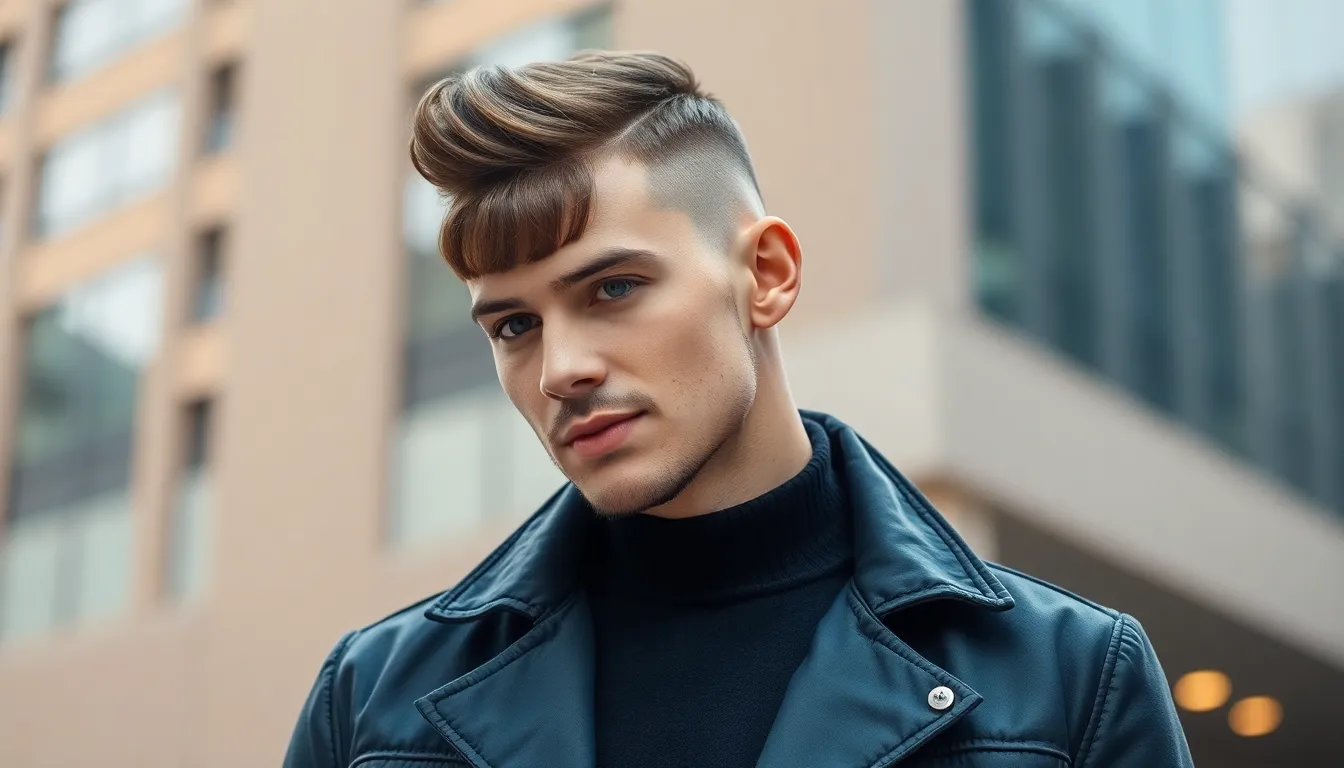
Blunt cut fringes deliver maximum visual impact through their sharp, geometric lines that frame the face with precision. This dramatic style creates an edgy contrast to the softer textures we’ve explored previously.
Achieving Sharp, Clean Lines
Professional precision becomes essential when creating the perfect blunt fringe that maintains its striking appearance. We recommend visiting a skilled barber who specializes in geometric cuts, as this style requires exact measurements and steady hands to achieve the desired effect.
Sectioning techniques determine the fringe’s overall shape and density across your forehead. Your stylist should create horizontal partings from temple to temple, ensuring the fringe section remains uniform in thickness. This methodical approach prevents uneven weight distribution that can compromise the blunt appearance.
Cutting angles must remain perfectly horizontal to maintain the signature straight edge that defines this style. The razor or scissors should move in one fluid motion across the hair, creating a clean line without any graduation or tapering. We’ve found that cutting the hair when it’s slightly damp provides better control and accuracy.
Regular maintenance keeps the blunt edge crisp and prevents the fringe from losing its bold impact. Schedule trims every 3 to 4 weeks to maintain the precise line, as even minor growth can soften the dramatic effect. Between salon visits, avoid trimming the fringe yourself, as maintaining the perfect horizontal line requires professional expertise.
Complementary Haircut Combinations
Undercut sides amplify the fringe’s boldness by creating stark contrast between the longer fringe and closely cropped side sections. This combination emphasizes the geometric nature of the blunt cut while adding modern edge to your overall appearance. The dramatic difference in lengths creates visual tension that draws attention to the precise fringe line.
Buzz cut backs provide clean backdrop for the dramatic fringe, allowing the blunt edge to become the focal point of your hairstyle. We recommend keeping the back section at a #2 or #3 guard length to maintain proportion with the longer fringe area. This combination works exceptionally well for men with strong jawlines and defined facial features.
Slicked back top sections create sophisticated contrast when paired with a blunt fringe, offering versatility for both casual and formal occasions. Use a medium-hold pomade to smooth the longer top hair backward while leaving the fringe to frame your face naturally. This styling approach balances the fringe’s boldness with refined elegance.
Textured crop combinations add subtle dimension without compromising the fringe’s clean lines. The slightly tousled top provides organic movement that softens the geometric precision of the blunt cut. Apply texturizing paste to the crown area while keeping the fringe smooth and straight for optimal contrast.
Asymmetrical Fringe for Edgy Modern Looks
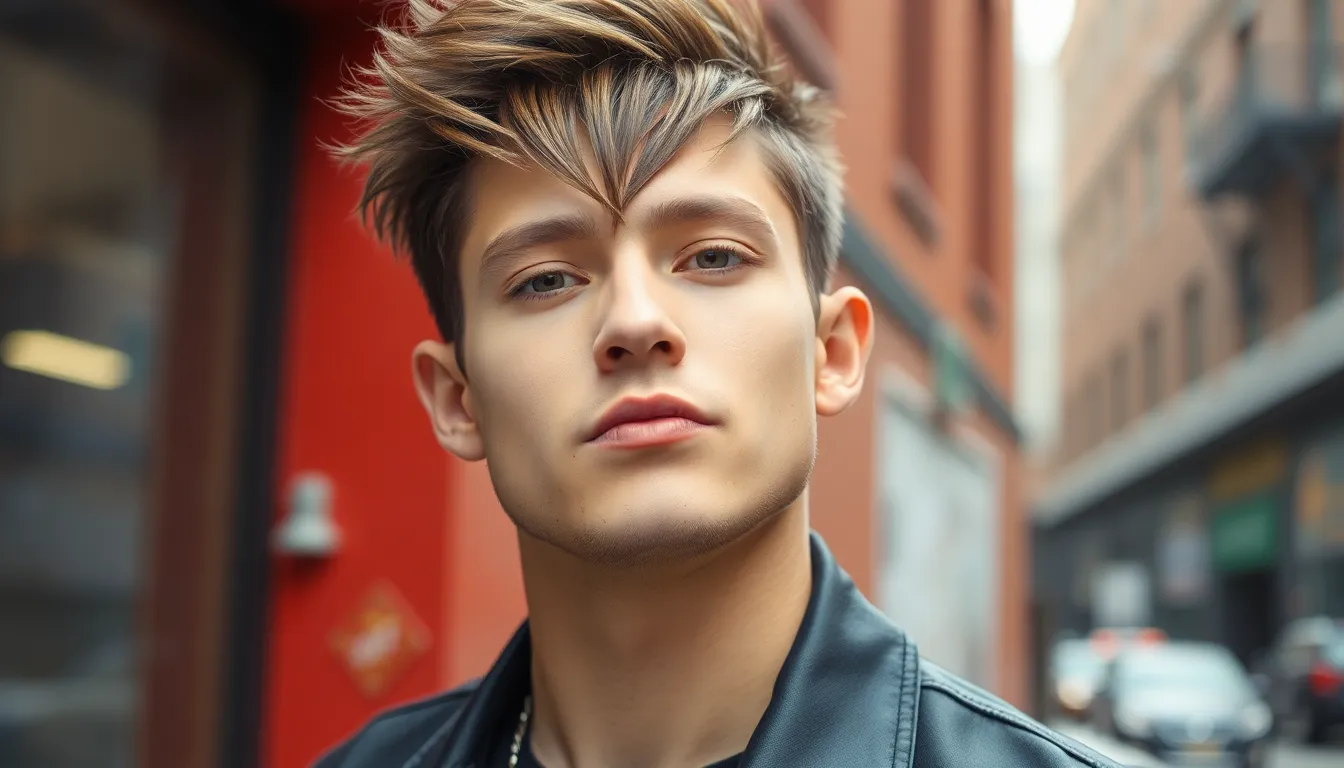
Asymmetrical fringe haircuts create striking visual interest through deliberately uneven lengths that challenge traditional styling conventions. We’ve noticed this rebellious approach to men’s fringe styling gaining momentum among fashion-forward individuals seeking distinctive appearance changes.
Design Variations and Angles
Angular cuts dominate the asymmetrical fringe industry, offering multiple creative possibilities for personal expression. Diagonal sweeps create the most popular variation, with longer sections on one side gradually transitioning to shorter lengths across the forehead. Sharp contrasts work exceptionally well for men with straight hair textures, allowing the geometric lines to remain crisp throughout the day.
Graduated angles provide softer transitions while maintaining the edgy aesthetic that defines asymmetrical styles. Barbers typically create these looks by cutting at 45-degree angles, starting from the longest point and working toward the shortest section. Extreme variations feature dramatic length differences of 2-3 inches between sides, creating bold statements perfect for creative professionals and artistic individuals.
Layered asymmetry combines multiple cutting techniques to achieve complex visual depth within the fringe area. Point cutting along the edges softens harsh lines while preserving the intentional imbalance that makes these styles so compelling. Razor cutting techniques add texture to thicker hair types, preventing the asymmetrical fringe from appearing too heavy on one side.
Styling Products for Texture Control
Texturizing paste becomes essential for maintaining the structural integrity of asymmetrical fringe designs throughout daily activities. We recommend products with medium hold strength that won’t weigh down the shorter sections while providing enough control for the longer pieces. Apply small amounts to damp hair, working the product through with fingertips to enhance natural movement patterns.
Matte finish pomades offer superior hold without creating unwanted shine that can distract from the geometric lines. Strong hold formulas work best for maintaining sharp angles, particularly in humid conditions where other products might fail. Work the pomade through towel-dried hair, using a small brush to define the asymmetrical edges with precision.
Sea salt sprays enhance texture in fine hair while adding grip that helps asymmetrical styles hold their shape longer. Spray evenly across the fringe area before blow drying, focusing extra product on the longer sections that tend to fall flat. Scrunching motions during the drying process activate the salt content, creating natural texture that complements the edgy styling.
Volumizing mousse provides lift at the roots without compromising the defined edges that make asymmetrical fringes so visually striking. Apply to damp hair before styling, concentrating on areas where the hair naturally wants to lie flat against the forehead. Blow dry with a round brush to direct hair in the desired asymmetrical pattern, finishing with a blast of cool air to set the shape.
Messy Fringe for Effortless Cool Vibes

Messy fringe haircuts deliver an effortlessly cool aesthetic that works perfectly for casual environments and relaxed styling routines. This versatile approach to fringe styling creates natural movement while maintaining an approachable, laid-back appearance.
Tousled Styling Techniques
Starting with slightly damp hair creates the perfect foundation for achieving that coveted messy texture. Apply a small amount of texturizing cream throughout your fringe section before styling begins.
Scrunching your fringe with your fingers while blow drying on low heat builds natural volume and movement. Avoid brushing or combing during this process to maintain the tousled effect.
Twisting small sections of your fringe around your finger creates definition and separates individual strands. Work through each section randomly rather than following a structured pattern for authentic messiness.
Using a diffuser attachment on your blow dryer enhances natural texture without creating frizz. Keep the heat setting on medium and the speed on low for optimal results.
Finishing with your hands by gently tousling the dried fringe adds final touches of controlled chaos. Shake your head lightly to settle the fringe into its natural fall pattern.
Products That Enhance Natural Texture
Sea salt spray provides the ideal base for messy fringe styling by adding grip and natural texture. Apply this product to damp hair before any heat styling begins.
Texturizing paste offers flexible hold while maintaining touchable softness throughout the day. Use a dime sized amount and work it through your fringe with your fingertips.
Dry shampoo creates instant volume and absorbs excess oils that can weigh down your messy fringe style. Spray lightly at the roots and massage gently with your fingers.
Lightweight mousse builds body without stiffness, making it perfect for fine hair that needs extra texture. Apply to damp hair and scrunch gently before air drying.
Matte finish hair powder adds instant grip and separation to create that perfectly imperfect messy appearance. Sprinkle a small amount onto dry hair and work through with your hands.
Short Micro Fringe for Minimalist Appeal

Short micro fringes represent the ultimate in understated sophistication, offering men a subtle yet impactful way to enhance their facial features. This precise style sits just above the eyebrows and creates clean lines that complement minimalist aesthetics perfectly.
Precision Cutting Requirements
Creating micro fringes demands exceptional technical skill from professional barbers who understand millimeter measurements. We recommend seeking stylists with at least 3 years of experience in precision cutting techniques, as even small mistakes become highly visible with this style. Professional tools including sharp haircutting shears, fine-tooth combs, and sectioning clips are essential for achieving the clean geometric lines that define micro fringes.
Measuring techniques require careful attention to eyebrow positioning and forehead proportions before making the first cut. Barbers typically section the hair using horizontal parting lines approximately 1 to 1.5 inches back from the hairline. Cutting angles must remain perfectly straight across to maintain the blunt micro effect that distinguishes this style from longer fringe variations.
Trimming frequency becomes crucial with micro fringes, as we suggest maintenance appointments every 2 to 3 weeks to preserve the precise length. Hair grows approximately 0.5 inches monthly, which means micro fringes can quickly lose their sharp definition without regular upkeep.
Face Shapes That Work Best
Oval face shapes benefit most from micro fringes because the horizontal line creates visual balance across well proportioned features. Men with oval faces can experiment with various micro fringe widths, from narrow temple-to-temple cuts to fuller versions that extend slightly beyond the eyebrows.
Square face shapes work well with micro fringes that soften angular jawlines through contrasting horizontal elements. We recommend keeping the fringe width moderate to avoid overwhelming strong facial features, while the short length prevents adding bulk to already broad face structures.
Long face shapes gain visual width from micro fringes that create the illusion of shortened facial proportions. Styling the micro fringe with slight texture rather than completely flat helps break up the straight lines and adds dimension to elongated features.
Heart shaped faces should approach micro fringes cautiously, as the horizontal line can emphasize narrow chins when not properly balanced. We suggest pairing micro fringes with textured side styling that adds volume around the temple area to create better facial proportions.
Round faces may find micro fringes challenging because the straight horizontal line can accentuate width rather than create definition. Consider consulting with experienced stylists who can adjust the fringe angle slightly to provide more flattering results for rounder facial structures.
Long Sweeping Fringe for Dramatic Effect
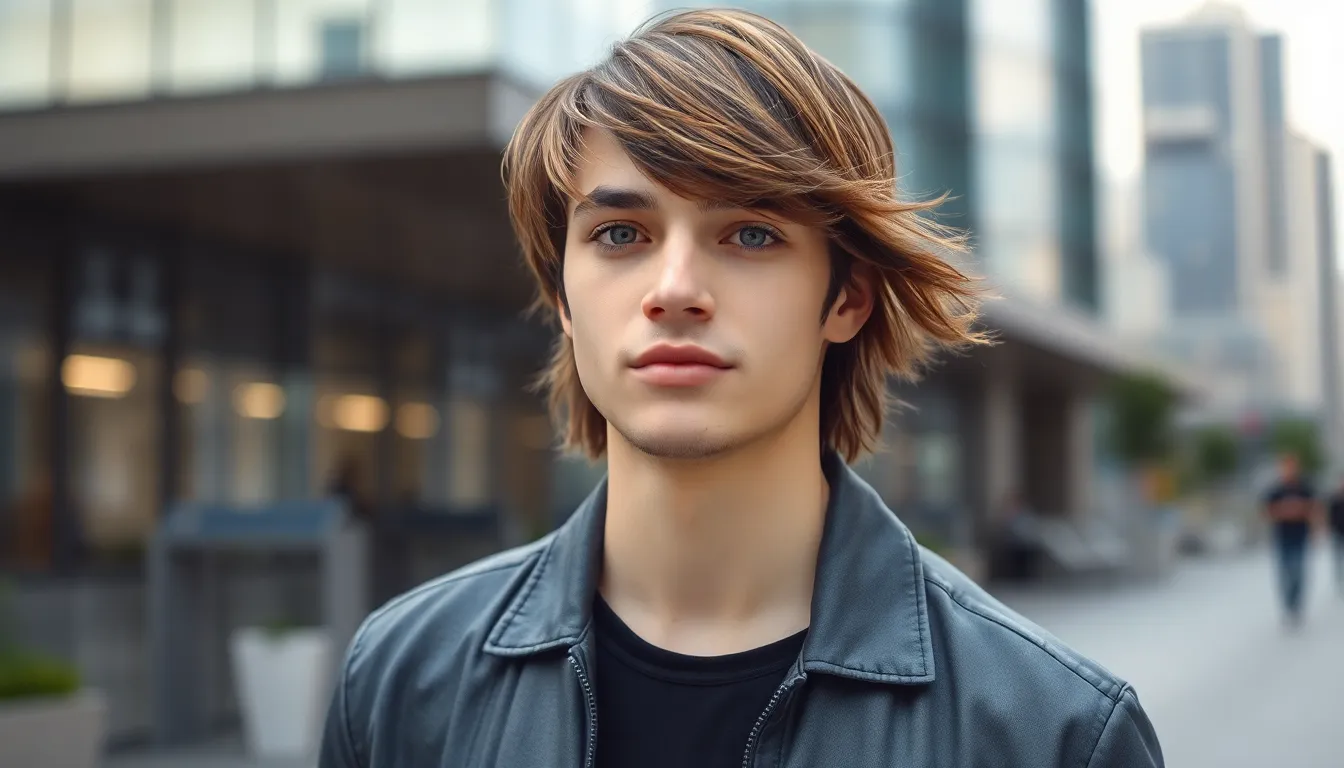
Long sweeping fringes create stunning visual impact through their flowing movement and sophisticated elegance. These dramatic cuts extend beyond traditional fringe lengths to deliver maximum style presence.
Length Considerations and Proportions
Optimal fringe length varies based on your face shape and desired dramatic effect. We recommend measuring from your hairline to achieve lengths that fall between your eyebrows and cheekbones for maximum visual impact.
Face shape determines the most flattering proportions for your sweeping fringe. Oval faces can handle longer lengths that extend past the eyebrows, while square faces benefit from softer angles that don’t emphasize jawline width.
Graduation techniques create the signature sweeping effect through strategic layering. Professional stylists use point cutting methods to remove bulk while maintaining length, allowing the fringe to fall naturally across your forehead.
Weight distribution requires careful planning to prevent the fringe from appearing too heavy. We suggest removing excess weight from the back sections while preserving length in the front pieces that create the dramatic sweep.
Proportional balance ensures your long fringe complements your overall haircut. The fringe should represent approximately 15-20% of your total hair mass to maintain proper visual weight distribution.
Daily Styling and Management Tips
Morning preparation starts with slightly damp hair and a quality round brush for smooth sweeping motion. Apply volumizing mousse at the roots to create lift and prevent the fringe from falling flat throughout the day.
Blow drying technique requires directing airflow in the opposite direction of your desired sweep. Use medium heat settings and finish with cool air to lock in the shape and add shine to your dramatic fringe.
Product selection focuses on lightweight formulas that won’t weigh down your long fringe. We recommend texturizing sprays for movement, light hold pomades for control, and finishing oils for glossy shine.
Brushing methods maintain the sweeping shape throughout the day using a small paddle brush. Gently guide the fringe in your preferred direction and avoid over brushing, which can create static and reduce volume.
Evening maintenance involves light misting with water and reshaping if needed. Sleep on silk pillowcases to reduce friction and preserve your styled sweep overnight.
Weekly treatments keep your long fringe healthy and manageable through deep conditioning masks. Focus conditioning products on the mid lengths and ends while avoiding the roots to prevent oil buildup.
Layered Fringe for Added Dimension
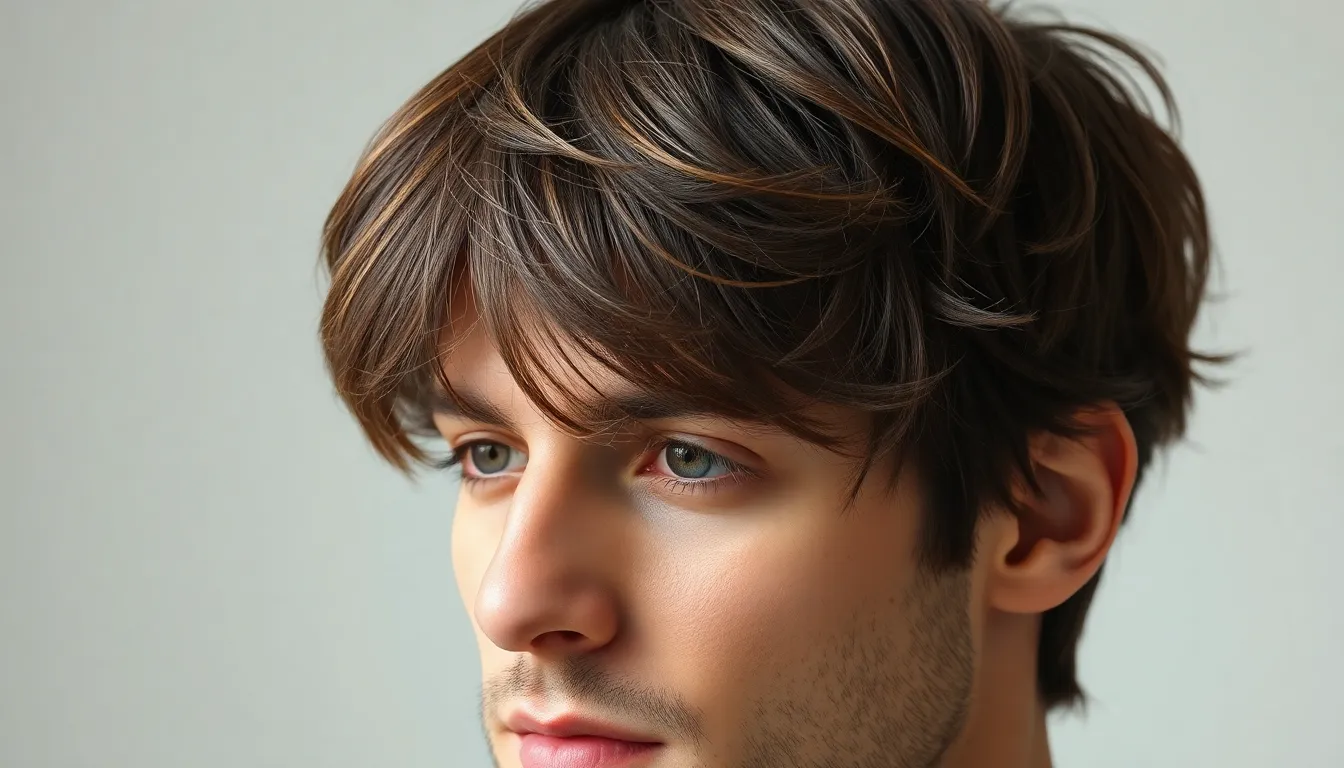
We’ve discovered that layered fringes transform flat, one-dimensional cuts into ever-changing styles that enhance natural texture and create visual depth.
Creating Depth and Movement
Graduated cutting techniques form the foundation of dimensional layered fringes that captivate with their natural flow. Professional stylists use point cutting methods to create varying lengths throughout the fringe section, establishing multiple levels that catch light differently. Razor cutting tools slice through hair at different angles, producing softer edges that blend seamlessly into surrounding layers.
Textural variation emerges when we combine different cutting techniques within a single fringe design. Scissors create clean lines for the base layer while thinning shears add feathered effects to upper sections. Strategic sectioning allows barbers to work with natural hair growth patterns, ensuring each layer falls naturally without forced positioning.
Movement enhancement occurs through careful consideration of hair density and thickness in each section. Dense areas receive more aggressive texturizing to prevent bulky appearance while finer sections maintain fuller cutting for adequate coverage. Diagonal cutting angles create forward motion that draws attention to facial features while maintaining balanced proportions.
Blending Techniques with Overall Cut
Seamless integration requires matching the fringe layers with existing haircut structure throughout the sides and back sections. Professional barbers extend the layering pattern from the fringe into temple areas using consistent cutting angles. Transition zones receive special attention to eliminate harsh lines between fringe and surrounding hair sections.
Length coordination ensures the longest fringe layers connect naturally with hair around the ears and neckline areas. Graduated cutting creates smooth transitions that maintain the overall silhouette while adding textural interest. Blending shears refine connection points where different hair sections meet, producing professional finish quality.
Styling product distribution becomes crucial for maintaining the layered fringe dimension throughout daily wear. Lightweight texturizing creams enhance separation between layers without weighing down shorter pieces. Application techniques focus on working products through individual layers rather than treating the fringe as one solid section, preserving the dimensional effect we’ve created through expert cutting methods.
Choosing the Right Fringe Style for Your Face Shape
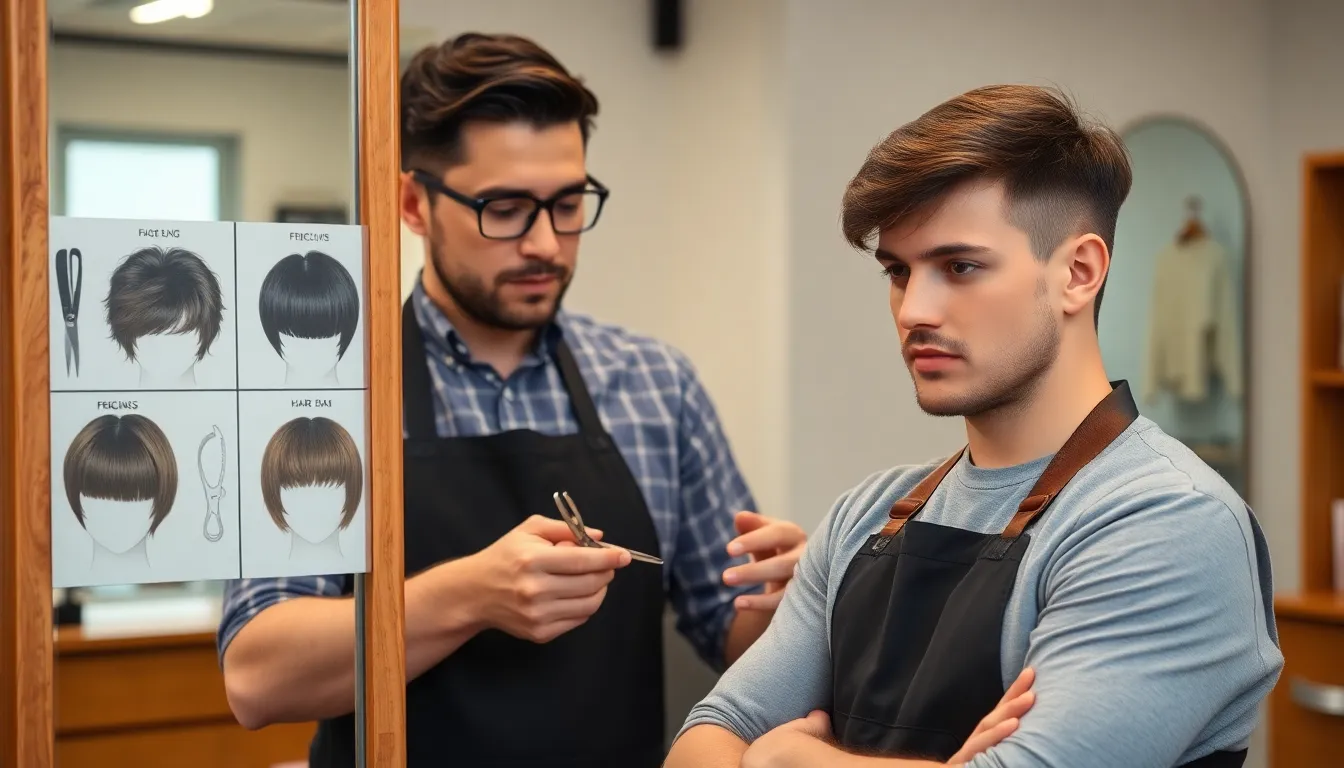
We’ve explored various fringe styles and their unique characteristics. Now let’s determine which exact fringe works best for your particular face shape to achieve the most flattering results.
Oval, Round, and Square Face Guidelines
Oval face shapes work exceptionally well with most fringe styles since they naturally provide balanced proportions. Blunt cut fringes create striking definition across the forehead, while side-swept styles add asymmetrical interest without overwhelming facial features. Textured choppy fringes enhance the natural balance, and curtain fringes frame the face beautifully with their flowing movement.
Round face shapes benefit from fringes that create length and angular definition. Side-swept fringes swept dramatically to one side help elongate the face and minimize width. Asymmetrical styles work particularly well by breaking up the circular symmetry with uneven lines. Long sweeping fringes create vertical emphasis that counteracts roundness. We recommend avoiding straight-across blunt cuts that might emphasize facial width.
Square face shapes need fringes that soften strong jawlines and add gentle curves. Textured choppy fringes create movement that reduces harsh angles, while layered styles provide dimensional softness. Messy fringes work excellently by introducing organic irregularity that contrasts with angular features. Curtain fringes parted slightly off-center help balance proportional strength without competing with existing structure.
| Face Shape | Best Fringe Styles | Styles to Avoid |
|---|---|---|
| Oval | Blunt cut, side-swept, textured choppy, curtain | Most styles work well |
| Round | Side-swept, asymmetrical, long sweeping | Straight-across blunt cuts |
| Square | Textured choppy, layered, messy, curtain | Sharp geometric lines |
Consulting with Professional Stylists
Professional stylists possess the technical expertise to assess your exact facial structure and recommend the most flattering fringe options. They analyze bone structure, hair growth patterns, and lifestyle factors that influence which styles will work best for your individual needs. Experienced barbers can identify subtle facial asymmetries and adjust fringe angles accordingly.
Booking a consultation allows stylists to examine your hair texture, density, and natural cowlicks that might affect fringe placement. They’ll discuss your maintenance preferences and styling comfort level to ensure you choose a fringe that fits your daily routine. Professional assessment prevents costly mistakes and ensures you receive a cut that enhances your best features.
During consultations, stylists can show you photo examples of different fringe styles on similar face shapes and hair types. They often use digital tools or styling techniques to temporarily demonstrate how various fringes might look before making permanent cuts. This preview process helps you make confident decisions about which style direction to pursue.
Quality stylists also provide detailed aftercare instructions and styling tutorials exact to your chosen fringe type. They’ll recommend appropriate products for your hair texture and show you techniques for maintaining your fringe between appointments. Professional guidance ensures your investment in a new fringe delivers the sophisticated results you’re seeking.
Conclusion
We’ve explored how fringe haircuts can transform your entire look from subtle side-swept styles to bold blunt cuts. The key to success lies in choosing the right style for your face shape and lifestyle needs.
Remember that professional consultation makes all the difference when selecting your perfect fringe. A skilled barber can assess your facial structure and recommend the most flattering option while ensuring precise execution.
With proper styling techniques and the right products you’ll maintain that fresh polished appearance throughout your day. Whether you’re aiming for workplace professionalism or casual sophistication there’s a fringe style that’ll elevate your personal aesthetic.
Frequently Asked Questions
What are the most popular fringe hairstyles for men?
The most popular men’s fringe styles include the classic side-swept fringe, textured choppy fringe, curtain fringe, blunt cut fringe, asymmetrical fringe, messy fringe, short micro fringe, long sweeping fringe, and layered fringe. Each style offers unique benefits, from professional workplace appropriateness to casual effortless appeal.
How do I choose the right fringe style for my face shape?
For oval faces, most fringe styles work well. Round faces benefit from off-center parting and asymmetrical styles. Square faces suit deeper side parts and softer textures. Heart-shaped faces look best with lower parting positions, while long faces need horizontal parting to create width illusion.
How often should I trim my fringe to maintain its shape?
Most fringe styles require trimming every 4-6 weeks to maintain their shape and prevent overgrowth. Blunt cut and micro fringes may need more frequent touch-ups every 3-4 weeks, while textured and messy styles can go slightly longer between cuts.
What products work best for styling men’s fringe haircuts?
Essential fringe styling products include volumizing mousse for lift, texturizing spray for movement, lightweight pomade for hold, sea salt spray for texture, and heat protectant for blow-drying. Choose matte finish products for casual looks and light-hold pomades for professional styles.
Can I style my fringe differently for work and casual occasions?
Yes, most fringe styles are versatile enough for both settings. Use lightweight pomade and structured styling for professional looks, then switch to texturizing products and tousled techniques for casual appearances. Side-swept and curtain fringes are particularly adaptable to different occasions.
How do I maintain fringe health and prevent damage?
Maintain fringe health by using deep conditioning treatments weekly, applying heat protectant before styling, avoiding excessive brushing when wet, and using lightweight products to prevent buildup. Regular professional trims also help prevent split ends and maintain hair integrity.
Should I cut my fringe myself or visit a professional?
Professional cutting is strongly recommended, especially for precise styles like blunt cuts and micro fringes. Skilled barbers understand sectioning techniques, face shape compatibility, and proper cutting angles. DIY maintenance can help between appointments, but initial cuts should be professional.
What hair types work best with fringe haircuts?
Fringe haircuts work with all hair types when properly executed. Fine hair benefits from volumizing techniques and textured styles. Thick hair suits blunt cuts and requires thinning techniques. Curly hair works well with longer, textured fringes, while straight hair is ideal for precise, geometric styles.

